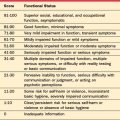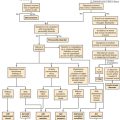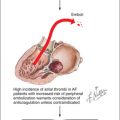CHAPTER 60 Care at the End of Life
OVERVIEW
With more than 2 million deaths each year in the United States,1 providing both competent and compassionate care for patients at the end of life is a crucial task for physicians. Caring for patients at the end of life occurs amidst an often complex background of medical, psychiatric, ethical, and legal concerns. This chapter provides an overview of the central principles of care, diagnosis, and treatment of the dying patient from the psychiatric perspective. It also examines current concepts in ethics, as well as legal precedents that surround this evolving area of medicine, where advances in medical technology and practice have extended the human life span and led to the emergence of both opportunities and conflicts at the end of life.
GOALS OF TREATMENT
An important first step in the treatment of the dying patient is for the psychiatrist and the patient to define treatment goals. According to Saunders,2 the primary aim of care is to help patients “feel like themselves” for as long as possible. Care at the end of life also offers an important opportunity, according to Kübler-Ross, to address and to complete “unfinished business.”3 Common themes in this category include reconciliation with estranged friends or family, resolution of conflicts with loved ones, and the pursuit of remaining hopes. Additionally, according to Kübler-Ross,3 patients who are dying go through a transformational process (which includes stages of denial, anger, bargaining, guilt/depression, and eventual acceptance). These stages may occur in a unique order, may occur simultaneously, and may last variable amounts of time. Psychiatrists and other physicians may assist the dying patient in the transition through these often difficult stages toward acceptance.
Hackett and Weisman4 also developed five goals for “appropriate death” that may focus therapeutic efforts for the treatment of a dying patient. These goals include freedom from pain, optimal function within the constraints of disability, satisfaction of remaining wishes, recognition and resolution of residual conflict, and yielding of control to trusted individuals. Perhaps more important than any other principle in the treatment of the dying patient is that the treatment be individualized. That is, within these general goals and paradigms, each patient’s unique characteristics will necessitate careful tailoring of clinical interventions. This case-by-case approach can be accomplished only by getting to know the patient, by responding to his or her needs and interests, by proceeding at his or her pace, and by allowing him or her to shape the manner in which those in attendance behave. There is no one “best” way to die.
Hospice can provide an important function for the dying patient by incorporating spiritual and family support, pain management, respite services, and a multidisciplinary ap-proach to medical and nursing care. When St. Christopher’s Hospice opened in 1967 with Saunders as medical director, it was dedicated to enabling a patient, according to Saunders, “to live to the limit of his or her potential in physical strength, mental and emotional capacity, and social relationships.”2 Saunders viewed hospice as the “alternative to the negative and socially dangerous suggestion that a patient with an incurable disease likely to cause suffering should have the legal option of actively hastened death, that is, euthanasia.”2
Currently, hospice provides home nursing, family support, spiritual counseling, pain treatment, medication, medical care, and some inpatient care for the terminally ill. In 1994,5 this numbered approximately 340,000 dying persons, and by 2005, more than 1 million patients received services from hospice.5 A decade ago, the average patient was enrolled roughly 1 month before his or her death, and the vast majority of patients had cancer.6–8 According to 2005 data, cancer diagnoses now account for less than 50% of hospice admissions, and growth in these admissions has been attributable to dementia, stroke or coma, and lung diseases.5 The average length of hospice enrollment in 2005 was nearly 2 months, with a median duration of 26 days.5 These increases in lengths of stay (LOS) were attributed to a decrease in the number of hospice admissions of 7 days or less and an increase in patients who received care for 6 months or longer.5 Medicare pays for the vast majority of hospice services; in 2005 more than 80% of hospice patients received services through their Medicare benefits.5 To qualify for hospice benefits, potential recipients of hospice care must have their physician and the hospice medical director certify that they are terminally ill and that they will live 6 or fewer months if their illness runs its normal course.9
THE ROLE OF THE PSYCHIATRIST
Psychiatrists can play a crucial role in the effective management of patients at the end of life because of their abilities to appreciate the medical aspects of disease, to understand the highly subjective and individual factors that contribute to the personal significance of illness, to understand personality styles and traits, and to engage with patients to modulate maladaptive responses to illness.10,11 To this end, the psychiatrist may serve many functions, including facilitating medical treatment, augmenting communication among the patient and his or her caregivers, and modeling those qualities that may be helpful for the patient. Above all, the psychiatrist’s primary goals are the diagnosis and management of psychiatric symptoms and illnesses. As for all other patients, a consideration of all factors that contribute to psychiatric suffering, including biological illnesses (Axis I and III), psychological style (Axis II), psychosocial factors (Axis IV), and functional capacity (Axis V), is essential. The most common issues that lead to psychiatric interventions for the dying patient include major depression, anxiety, personality disorders, delirium and other organic brain syndromes, refractory pain, substance abuse, and difficulties surrounding bereavement.12,13
Depression
The more seriously ill a person becomes, the more likely the person is to develop major depression.14 Careful vigilance for depression is necessary, as both symptoms of depression and the impact of depression on other aspects of the patient’s life and medical care are problematic. For example, Weisman formulated the wish to die as an existential signal that the person’s conviction “that his potential for being someone who matters has been exhausted.”15 Ganzini and colleagues16 documented that severely depressed patients made more restricted advance directives when depressed, and they changed them after their depression remitted. At Memorial Sloan Kettering Cancer Center, Breitbart and Holland17 compared terminally ill patients with cancer and acquired immunodeficiency syndrome (AIDS) with suicidal ideation to similar patients with-out suicidal ideation. The primary difference was the presence of depression in the patients with suicidal thoughts.17 Thus, aggressive treatment of depression is a cornerstone of care, as it dramatically decreases suffering and improves quality of life. In terms of specific treatments, psychiatrists may consider the use of rapidly acting treatments that target specific symptoms. In addition to antidepressants, stimulants are another useful class of agents; they have several advantages, including the rapid onset of improved mood and potentiation of co-administered narcotics (with less accompanying sedation).
Suicidal ideation, if it appears, should not be thought of as an “understandable” response but rather as a condition that warrants immediate investigation and treatment.13 It is also important to differentiate suicidal ideation from a stated desire to hasten death. The desire to hasten death has been identified consistently among a minority of terminally ill patients.18–20 While the desire to hasten death is frequently associated with depression, other factors (such as pain, existential concerns, loss of function, and social circumstances) also play critical roles.18–27 The psychiatric consultant needs to listen carefully to the patient who desires hastened death, to treat any underlying psychiatric or physical problem, and to take steps to lessen distress.24
Anxiety
Anxiety frequently occurs as the end of life and requires psychiatric attention.12,13 Impending death can generate severe anxiety in those who face death themselves, as well as their family members, friends, and caregivers. The patient who experiences anxiety surrounding death may not necessarily be able to articulate his or her fears, although anxiety may be related to prior losses or experiences that involve the death of others. Common fears associated with death include helplessness or loss of control, ideas of guilt and punishment, physical pain or injury, and abandonment.12–14,28,29 The psychiatrist can be helpful by addressing these fears and by exploring issues of isolation, abandonment, and suffering. Appropriate attention should also be directed toward psychopharmacological management of anxiety symptoms.
Personality Considerations
The terminally ill patient who has a personality disorder (such as narcissistic or borderline personality disorder) or other coping difficulties can present a particular challenge for care providers. For such a patient, help is hard if not impossible to accept and trust, which can interfere with his or her ability to take comfort from those around them.10,12,13 For such a patient, much of the situation is out of his or her immediate control; this elicits regression and the use of more primitive defenses (such as splitting). This may manifest as poor communication with treaters, inadequate pain control, and difficulty in the resolution of interpersonal conflicts.13 Psychiatrists may find it useful to call on psychodynamic diagnostic and treatment skills to assist such a person in accepting palliative care.12 Treaters can help to transform the negative countertransference (on the part of caretakers) into an understanding of how best to help the patient undergo the dying process.12,13 Working closely with family and friends of the patient, as well as the medical team, is important in these situations.12,13
Delirium and Cognitive Changes
As terminal illness progresses, medical complications (such as delirium and other cognitive changes) can occur. These complications can manifest as confusion, psychosis, agitation, or a multitude of other symptoms and can be caused by the medical illness, its treatment, or both. Effective management of changes in affect, behavior, and cognition due to delirium is important, as it can indicate worsening of medical illness and can greatly affect the quality of time spent with friends, family, and caretakers.12,13
Pain
Pain management can be a complex challenge requiring extensive expertise. Freedom from pain is basic to every care plan, and it should be achievable in most cases.12 However, for a multitude of reasons, pain is often undertreated by medical staff.30–34 Pain management may be particularly challenging for a patient with a history of substance dependence; patients with a history of addiction are more likely to receive inadequate pain management than patients without a history of substance abuse or dependence.11,35,36 This may be due to concerns about higher-than-expected (and escalating) doses of opiates, potential misuse or diversion, and fears of legal consequences of prescribing narcotics to a patient with substance dependence.35,37 Evidence of abuse may include unexpectedly positive results of toxicology screens, frequent requests for higher doses, recurrent reports of lost prescriptions, and multiple visits to various providers or emergency departments for prescription refills.38 Physicians who prescribe to such patients may have divergent opinions on the treatment of substance dependence in the terminally ill. Some physicians feel that carefully monitoring a terminally ill patient on an opiate or actively treating the patient’s substance dependence deprives the patient; however, optimal relief of suffering mandates acknowledgement and treatment of active substance abuse issues.39 The goal of care requires the physician to separate the management of the patient’s pain from the management of addiction and to treat both.11,40 Careful monitoring of a patient’s narcotic use, use of a multidisciplinary team, encouragement of substance abuse treatment, limitation of prescribing power to a single provider, and utilization of screening tests (e.g., urine toxicology) may all be useful in the management of the terminally ill person with substance dependence.41
Psychosocial Considerations
Optimal end-of-life care includes an understanding of the major areas of psychosocial concern, such as family, work, religion, faith, ethnicity, and culture. The presence of the family is crucial to help a patient resolve long-standing conflicts (if possible) and to provide a context for honoring and remembering the patient.12 Psychiatrists can aid the family by encouraging the sharing of feelings among family members and by helping to create specific plans for the family (such as the compilation of commemorative items).13 At the same time, an understanding of the complexities of family interactions (both positive and negative) helps prevent harm to a potentially fragile family system. For example, a recent randomized clinical trial of family-focused grief therapy found that it could help prevent pathological grief in family members; however, it also had the potential to increase conflict in families where the level of hostility was high.42
As with family relationships, a sense of vocational identity can help create meaning for a patient at the end of life.12 For some, work can be critical for self-esteem. As a patient can begin to feel less valuable when work ceases or retirement arrives, the presence of former and current colleagues can be quite supportive.
Similarly, thoughtful discussion about a patient’s beliefs and faith can provide an opportunity for a patient to further his or her sense of meaning and thoughts about an afterlife.13 Many patients are grateful for the chance to express thoughts about their faith. The patient’s own clergyperson, if available, can often provide valuable information and insights about the patient and family and help smooth the course before death. Writers such as Allport43 and Feifel44 have contrasted an extrinsic religious orientation (in which religion is mainly a means to social status, security, or relief from guilt) with an intrinsic religious orientation (in which the values appear to be internalized and subscribed to as ends in themselves). Experimental work45 and clinical experience12 indicate that an extrinsic value system, without internalization, seems to offer less assistance in coping with a fatal illness than intrinsic religious commitment (which can offer considerable stability and strength).
Last, patients from underserved communities or minority populations within the United States may have needs that may not be served by the current health care system. Unfortunately, the same institutional, cultural, and individual factors that generate disparities in care for minority populations in general also affect care at the end of life.46 These factors include lack of access to care, undertreatment of pain, and mistrust of the health care system.46–48 Further, important differences among ethnic groups and cultures can be found at all segments of end-of-life care. For example, several studies have shown that African American patients, as well as older individuals from other ethnic backgrounds (such as Latino, Asian, or Native American), are somewhat less likely to have arranged for an advance directive as compared to Caucasian patients.49 There are also important differences in terms of preferences for life-sustaining treatment. For example, in a study involving multiple ethnic groups, African Americans had the highest rate of preferring life-sustaining treatment, and European Americans had the lowest rates.50 Multiple other studies have demonstrated a preference by African Americans to choose more life-sustaining treatment and cardiopulmonary resuscitation in the face of terminal illness.46,51–54
Additionally, culture may also influence the decision-making process. For example, family-centered (rather than individual) decision-making is common in certain ethnic groups within the United States, which challenges the traditional Western model of the importance of individual autonomy.46 Studies have found a higher use of family-centered decision-making among Latino and Asian groups in the United States, which may include the decision to disclose (or not to disclose) the diagnosis of a terminal illness to an individual patient.49 Thus, attention to cultural competency by psychiatrists plays a significant role in mediating end-of-life care for patients from all ethnicities and cultures.
ETHICS AND END-OF-LIFE CARE
Principles
The primary obligation of the physician to the patient in traditional medical ethics has been expressed in both positive and negative terms. The negative goal, always referred to first, is not to harm the patient (primum non nocere). The positive obligation is to restore health, to relieve suffering, or both. Our contemporary dilemma, as Slater55 has pointed out, arose because we now have many situations in which these two aims come into conflict (i.e., the more aggressive the efforts to reverse an incurable illness, the more suffering is inflicted on the patient). For example, if a 70-year-old man with large cell cancer of the lung is found to have metastatic spread of the disease to the other lung and to his liver, any treatment of the cancer is likely to make him feel worse and would be unlikely to prolong his survival.
Second, modern medicine respects patients’ right to autonomy. This principle guarantees any competent patient the right to refuse any treatment, even a life-saving one. This was the emphasis of the medical ethics of the 1970s and 1980s and it focused on refusing life-prolonging treatment, such as mechanical ventilation, and more recently, nutrition and hydration. Honoring such refusals presupposes that the patient is competent. It is important to remember that competent patients may make decisions that providers may view as irrational.56 However, a patient cannot insist that the physician provide treatment that is considered futile.57–60 Defining futility continues to be a goal of medical ethics as a balance is forged between the autonomy interest of patients to opt for aggressive treatment and concern by physicians that there is a duty not to offer or provide treatments that are ineffective.61,62
Limitation of Life-Sustaining Treatment
However, complications emerge when a patient is not able to make or voice a decision regarding his or her wishes. In these situations, the state has a recognized legal interest in preserving life, and it may be difficult to ascertain whether the patient had a countervailing autonomy interest. One historical example is the case of Karen Ann Quinlan, a 21-year-old woman who in 1976 fell into an irreversible coma while at a party. This case became a legal battle between the right of Quinlan’s mother (who as her guardian wished to withdraw life-sustaining treatment from her daughter and allow her daughter to die with dignity) and the state’s interest in preserving life. In the end, the Supreme Court of New Jersey decided that, if it was believed, to a reasonable degree, that the coma was irreversible, life-sustaining treatment (e.g., with a respirator) could be removed.63 Now, more than 30 years later, the standard medical recommendation in the case of irreversible coma is to stop all treatment (including nutrition and hydration). This judgment is made on the principle of the inevitability of death and the futility of any treatments to prevent this.
For patients in a persistent vegetative state (a state in which patients have a functioning brainstem but total loss of cortical function) a complicated scenario emerges.64,65 The many clinical dilemmas in this condition are perhaps best exemplified by the Nancy Cruzan case in 1990. Seven years after the automobile accident that left her in a persistent vegetative state, Nancy Cruzan’s feeding tube was removed. She died 12 days later. Her parents’ request that the tube be removed initiated a journey that took them through the state and federal court system, up to the United States Supreme Court. The United States Supreme Court’s decision66,67 affirmed that competent patients have the right to refuse treatment, that forgoing nutrition and hydration is no different from forgoing other medical treatment (such as artificial ventilation or pressor agents), but that Missouri (and other states) could require “clear and convincing evidence” that the patient, while still competent, had rejected the idea of life-sustaining treatment under such circumstances. That is, the autonomy interest of the patient in a persistent vegetative state had to be weighed against the state’s interest in protecting life. However, according to the United States Supreme Court, while Missouri could require clear and convincing evidence of a patient’s wishes when that patient was previously competent, states could also adopt less rigorous standards.
The complicated scenario of the persistent vegetative state was more recently revisited in the Theresa Schiavo case of 2004.68 In this case, Theresa Schiavo was determined to be in a persistent vegetative state and her husband, who was her guardian, wished to withdraw life-sustaining nutrition and hydration from her, in accordance with what he believed her wishes would have been. However, her parents opposed removal of the life-sustaining measures. Although the Florida Supreme Court’s decision rested on a narrow legal analysis of the proper powers of each branch of the state government, the case revived public debate about withdrawal of care at the end of life. Following the case, many states began debating the amount of proof required to establish that an incompetent patient, when competent, would have opted to have his or her life-sustaining care withdrawn.
CONCLUSION
In conclusion, the aim of end-of-life care is to maximize the quality of life and to minimize the suffering of patients who are terminally ill. For many patients, the end of life marks an important opportunity to reflect, reconcile, and pursue remaining hopes. The psychiatrist can play an important role both in the diagnosis and treatment of psychiatric illness in this setting, as well as facilitating treatment, enhancing communication, and modeling caregiver qualities for families. From a psychiatric perspective, major depression and anxiety are commonly seen; and suicidality should not be considered “understandable” or “normal” in this setting. Delirium, pain, and difficulties with coping are also common reasons for consultation requests. As in all other forms of psychiatric evaluation and treatment, it is crucial to consider any medical contribution to psychiatric symptoms. Aggressive treatment of depression, anxiety, and other psychiatric symptoms is a crucial part of holistic management. Additionally, psychosocial factors may also play an important (and, at times, complicating) role in the care of these patients. Psychiatrists also should be aware of, and prepared to manage, many of the complex ethical and legal issues that arise in the care of these patients. Physicians have clear obligations in caring for their patients, and patients have rights to autonomy in their decision-making.
1 Minino AM, Heron MP, Smith BL. Deaths: preliminary data for 2004. Natl Vital Stat Rep. 2006;54(19):1-52.
2 Saunders C, editor. The management of terminal illness. Chicago: Year Book Medical, 1978.
3 Kübler-Ross E. On death and dying. New York: MacMillan, 1969.
4 Hackett TP, Weisman AD. The treatment of the dying. Curr Psychiatr Ther. 1962;2:121-126.
5 National Hospice and Palliative Care Organization. NHPCO’s facts and figures—2005 findings. Available at www.nhpco.org/files/public/2005-facts-and-figures.pdf. (accessed February 21, 2007).
6 Haupt B. An overview of home health and hospice care patients: 1996 national home and hospice survey. Adv Data. 1998;297:1-35.
7 Haupt B. Characteristics of hospice care users: data from the 1996 national home and hospice care survey. Adv Data. 1998;299:1-16.
8 Christakis NA, Iwashyna TJ. Impact of individual and market factors on the timing of initiation of hospice terminal care. Med Care. 2000;38(5):528-541.
9 Centers for Medicare and Medicaid Services. Medicare hospice benefits. Available at www.medicare.gov. (accessed February 21, 2007).
10 Kim HF, Greenberg DB. Coping with medical illness. In Stern TA, Herman JB, editors: Massachusetts General Hospital psychiatry update and board preparation, ed 2, New York: McGraw-Hill, 2004.
11 Brendel RW, Cohen MA. End-of-life issues. In: Cohen MA, Gorman JM, editors. Comprehensive textbook of AIDS psychiatry. New York: Oxford University Press; 2008:567-576.
12 Cassem NH, Brendel RW. End of life issues: principles of care and ethics. In Stern TA, Fricchione GL, Cassem NH, et al, editors: Massachusetts General Hospital handbook of general hospital psychiatry, ed 5, Philadelphia: Mosby, 2004.
13 Reddick B, Brendel RW, Cassem NH. Treatment decisions at the end of life. In Stern TA, Herman JB, editors: Massachusetts General Hospital psychiatry update and board preparation, ed 2, New York: McGraw-Hill, 2004.
14 Cassem NH. Depression and anxiety secondary to medical illness. Psychiatr Clin North Am. 1990;13:597-612.
15 Weisman AD: Personal communication.
16 Ganzini L, Lee MA, Heintz RT, et al. The effect of depression treatment on elderly patients’ preferences for life-sustaining medical therapy. Am J Psychiatry. 1994;151:1631-1636.
17 Breitbart W, Holland JC, editors. Psychiatric aspects of symptom management in cancer patients. Washington, DC: American Psychiatric Press, 1993.
18 Breitbart W, Rosenfeld B, Pessin H, et al. Depression, hopelessness, and desire for hastened death in terminally ill patients with cancer. JAMA. 2000;284(22):2907-2911.
19 Chochinov HM, Wilson KG, Enns M, et al. Desire for death in the terminally ill. Am J Psychiatry. 1995;152(8):1185-1191.
20 Kelly B, Burnett P, Pelusi D, et al. Factors associated with the wish to hasten death: a study of patients with terminal illness. Psychol Med. 2003;33(1):75-81.
21 Jones JM, Huggins MA, Rydall AC, et al. Symptomatic distress, hopelessness, and the desire for hastened death in hospitalized cancer patients. J Psychosom Res. 2003;55(5):411-418.
22 O’Mahoney S, Goulet J, Kornbluth A, et al. Desire for hastened death, cancer pain, and depression: report of a longitudinal study. J Pain Symptom Manage. 2005;29(5):446-457.
23 Chochinov HM, Hack T, Hassard T, et al. Dignity in the terminally ill: a cross-sectional, cohort study. Lancet. 2002;360(9350):2026-2030.
24 Maytal G, Stern TA. The desire for death in the setting of terminal illness: a case discussion. Prim Care Companion J Clin Psychiatry. 2006;8(5):299-305.
25 Albert SM, Rabkin JG, DelBene ML, et al. Wish to die in end-stage ALS. Neurology. 2005;65(1):68-74.
26 Rabkin JG, Wagner GJ, DelBene ML. Resilience and distress among amyotrophic lateral sclerosis patients and caregivers. Psychosom Med. 2000;62(2):271-279.
27 Veldink JH, Wokke JHJ, VanDerWal G, et al. Euthanasia and physician-assisted suicide among patients with amyotrophic lateral sclerosis in the Netherlands. N Engl J Med. 2002;346:1638-1644.
28 Deutsch F. Euthanasia, a clinical study. Psychoanal Q. 1933;5:347-368.
29 Freud S, The ego and the id Strachey J, editor. Standard edition, vol 19. London: Hogarth Press, 1961.
30 Cleeland CS, Gonin R, Hatfield AK, et al. Pain and its treatment in outpatients with metastatic cancer. N Engl J Med. 1994;330:592-596.
31 Kimball LR, McCormick WC. The pharmacologic management of pain and discomfort in persons with AIDS near the end of life: use of opioid analgesia in the hospice setting. J Pain Symptom Manage. 1996;11:88-94.
32 The SUPPORT Principal Investigators. A controlled trial to improve care for seriously ill hospitalized patients. JAMA. 1995;274:1591-1598.
33 Hill CSJr. The barriers to adequate pain management with opioid analgesics. Semin Oncol. 1993;20(suppl):1-5.
34 Reidenberg MM. Barriers to controlling pain in patients with cancer. Lancet. 1996;347:1278.
35 Gilson AM, Joranson DE. U.S. policies relevant to the prescribing of opioid analgesics for the treatment of pain in patients with addictive disease. Clin J Pain. 2002;18(4):S91-S98.
36 Breitbart W, Rosenfeld B, Passik S, et al. A comparison of pain report and adequacy of analgesia in ambulatory AIDS patients with and without a history of substance abuse. Pain. 1997;72(1-2):235-243.
37 Breibart W, Kaim M, Rosenfeld B. Clinicians’ perception of barrier to pain management in AIDS. J Pain Symptom Manage. 1999;18(3):203-212.
38 Ballantyne JC, Mao J. Opioid therapy for chronic pain. N Engl J Med. 2003;349(20):1943-1953.
39 Passik SD, Theobald DE. Managing addiction in advanced cancer patients: why bother? J Pain Symptom Manage. 2000;19(3):229-234.
40 Renner JA, Gastfriend DR. Drug-addicted patients. In Stern TA, Fricchione GL, Cassem NH, et al, editors: Massachusetts General Hospital handbook of general hospital psychiatry, ed 5, Philadelphia: Mosby, 2004.
41 Kirsh KL, Passik SD. Palliative care of the terminally ill drug addict. Cancer Invest. 2006;24(4):425-431.
42 Kissane DW, McKenzie M, Bloch S, et al. Family focused grief therapy: a randomized, controlled trial in palliative care and bereavement. Am J Psychiatry. 2006;163:1208-1218.
43 Allport G. The nature of prejudice. New York: Doubleday, 1958.
44 Feifel H. Religious conviction and fear of death among the healthy and the terminally ill. J Sci Study Religion. 1974;13:353-360.
45 Magni KG. The fear of death. In: Godin A, editor. Death and presence. Brussels: Lumen Vitae, 1972.
46 Krakauer EL, Crenner C, Fox K. Barriers to optimum end-of-life care for minority patients. J Am Geriatr Soc. 2002;50:182-190.
47 Crawley V, Payne R, Bolden J, et al. Palliative and end-of-life care in the African-American community (commentary). JAMA. 2000;284(19):2518-2521.
48 Perkins HS, Geppert CM, Gonzales A, et al. Cross-cultural similarities and differences in attitudes about advance care planning. J Gen Intern Med. 2002;17(1):48-57.
49 Kwak J, Haley WE. Current research finding on end-of-life decision making among racially or ethnically diverse groups. Gerontologist. 2005;45(5):634-641.
50 Blackhall LJ, Frank G, Murphy ST, et al. Ethnicity and attitudes toward life-sustaining technology. Soc Sci Med. 1999;48:1779-1789.
51 Caralis PV, Davis B, Wright K, Marcial E. The influence of ethnicity and race on attitudes toward advance directives, life-prolonging treatments, and euthanasia. J Clin Ethics. 1993;4(2):155-165.
52 Garrett JM, Harris RP, Norburn JK, et al. Life-sustaining treatments during terminal illness: who wants what? J Gen Intern Med. 1993;8(7):361-368.
53 O’Brien LA, Grisso JA, Maisline G, et al. Nursing home residents’ preferences for life-sustaining treatments. JAMA. 1995;274(22):1775-1779.
54 Phillips RS, Wenger NS, Teno J, et al. Choices of seriously ill patients about cardiopulmonary resuscitation: correlates and outcomes. Am J Med. 1996;100(2):128-137.
55 Slater E. New horizons in medical ethics. BMJ. 1973;2:285-286.
56 Brock DW, Wartman SA. When competent patients make irrational choices. N Engl J Med. 1990;322:1595-1599.
57 Consensus report on the ethics of forgoing life-sustaining treatments in the critically ill. Task Force on Ethics of the Society of Critical Care Medicine. Crit Care Med. 1990;18:1435-1439.
58 Taffet GE, Teasdale TA, Luchi RJ. In-hospital cardiopulmonary resuscitation. JAMA. 1988;260:2069-2072.
59 Murphy DJ. Do-not-resuscitate orders. JAMA. 1988;260:2098-2101.
60 Tomlinson T, Brody H. Futility and the ethics of resuscitation. JAMA. 1990;164:1276-1280.
61 Pellegrino ED. Ethics. JAMA. 1993;270:202-203.
62 Jecker NS, Schneiderman LJ. The duty not to treat. Camb Q Health Care Ethics. 1993;2:151-159.
63 In re Quinlan, 70 N.J. 10 (1976).
64 Position of the American Academy of Neurology on certain aspects of the care and management of the persistent vegetative state patient. Adopted by the Executive Board, American Academy of Neurology, April 21, 1988. Neurology. 1989;39:125-126.
65 Munsat TL, Stuart WH, Cranford RE. Guidelines on the vegetative state: commentary on the American Academy of Neurology statement. Neurology. 1989;39:123-124.
66 Cruzan v. Director, Missouri DMH, 497 U.S. 261, 110 S.Ct. 2841 (1990).
67 Annas GJ, Arnold B, Aroskar M, et al. Bioethicists’ statement on the U.S. Supreme Court’s Cruzan decision. N Engl J Med. 1990;323:686-688.







